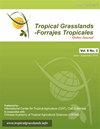Protein and carbohydrate fractionation of silages made from maize, Urochloa species and their mixtures
IF 0.7
4区 农林科学
Q3 AGRICULTURE, DAIRY & ANIMAL SCIENCE
引用次数: 3
Abstract
New feed assessment systems and methodologies for ruminants are being used with the aim of maximizing the use of nutrients by animals. The Cornell Net Carbohydrate and Protein System (CNCPS) considers the dynamics of ruminal fermentation and the potential loss of nitrogen in feed evaluation. We used this system to evaluate the protein and carbohydrate fractionation of silages made from maize and Urochloa species alone and in combination (70:30). The experiment was carried out under a completely randomized experimental design with 4 replications. Treatments comprised silages made from the following forages: maize (Zea mays); Congo grass (Urochloa ruziziensis); Xaraes palisadegrass (U. brizantha 'Xaraés'); Paiaguas palisadegrass (U. brizantha 'BRS Paiaguás'); 70% maize + 30% Congo grass; 70% maize + 30% Xaraes palisadegrass; and 70% maize + 30% Paiaguas palisadegrass. The results showed that despite the Urochloa exclusive silages having higher crude protein concentration than maize and mixed silages, they have a higher proportion of unavailable fractions with slow degradation rates, which can compromise animal performance. The maize silage and mixed silages had higher percentages of protein and carbohydrates with high degradation potential than Urochloa exclusive silages. Therefore, mixed silages represent one more alternative to provide forage with good nutritional value for ruminant feeding in times of feed shortage. Mixing grass and maize at ensiling would increase the volume of silage produced relative to ensiling maize alone without any significant reduction in quality of the silage produced. However, further studies are needed to determine the appropriate combinations of maize and grass at ensiling to produce silage with the desired nutritional value for the particular application and class of animals being fed. Feeding studies with animals would verify production levels achieved with the various silages.玉米、Urochloa物种及其混合物制成的青贮饲料的蛋白质和碳水化合物分级
目前正在使用新的反刍动物饲料评估系统和方法,目的是最大限度地利用动物的营养物质。康奈尔净碳水化合物和蛋白质系统(CNCPS)在饲料评估中考虑了瘤胃发酵的动力学和氮的潜在损失。我们使用该系统来评估由玉米和Urochloa物种单独和组合制成的青贮饲料的蛋白质和碳水化合物分级(70:30)。该实验是在完全随机的实验设计下进行的,有4个重复。处理包括由以下牧草制成的青贮饲料:玉米(玉米);刚果草(Urochloa ruziziensis);Xaraes palisadegrass(U.brizantha‘Xaraés’);Paiaguas palisadegrass(U.brizantha‘BRS Paiaguás’);70%玉米+30%刚果草;70%的玉米+30%的泽拉斯栅栏;70%的玉米+30%的帕亚瓜斯栅栏草。结果表明,尽管Urochloa专用硅烷具有比玉米和混合硅烷更高的粗蛋白浓度,但它们具有更高比例的不可用组分,降解速率较慢,这可能会影响动物的性能。玉米青贮饲料和混合青贮饲料的蛋白质和碳水化合物百分比高于乌罗奇洛阿专用青贮饲料,具有较高的降解潜力。因此,混合青贮饲料代表了在饲料短缺时为反刍动物提供具有良好营养价值的饲料的又一种选择。与单独青贮玉米相比,在青贮时混合草和玉米将增加青贮饲料的产量,而不会显著降低青贮饲料的质量。然而,还需要进一步的研究来确定青贮玉米和草的适当组合,以生产具有特定应用和饲养动物类别所需营养价值的青贮饲料。对动物的饲养研究将验证各种青贮饲料的生产水平。
本文章由计算机程序翻译,如有差异,请以英文原文为准。
求助全文
约1分钟内获得全文
求助全文
来源期刊

Tropical Grasslands-Forrajes Tropicales
Agricultural and Biological Sciences-Agronomy and Crop Science
CiteScore
1.60
自引率
0.00%
发文量
36
审稿时长
16 weeks
期刊介绍:
The Journal publishes, in English or Spanish, Research Papers and Short Communications on research and development, as well as contributions from practitioners (Farmer Contributions) and Review Articles, related to pastures and forages in the tropics and subtropics. There is no regional focus; the information published should be of interest to a wide readership, encomprising researchers, academics, students, technicians, development workers and farmers.
In general, the focus of the Journal is more on sown (''improved'') pastures and forages than on rangeland-specific aspects of natural grasslands, but exceptions are possible (e.g. when a submission is relevant for a particularly broad readership in the pasture and forage science community).
The Journal will also consider the occasional publication of associated, but closely related, research in the form of an additional scientific communication platform [e.g. a re-make of the former Genetic Resources Communication series of the former Division of Tropical Crops and Pastures of the Commonwealth Scientific and Industrial Research Organisation (CSIRO), Australia].
Areas of particular interest to the Journal are:
Forage Genetic Resources and Livestock Production[...]
Environmental Functions of Forages[...]
Socio-economic Aspects[...]
Topics within the aforementioned areas may include: Diversity evaluation; Agronomy; Establishment (including fertilization); Management and utilization; Animal production; Nutritive value; Biotic stresses (pests and diseases, weeds); Abiotic stresses (soil fertility, water, temperature); Genetics and breeding; Biogeography and germplasm collections; Seed production; Ecology; Physiology; Rhizobiology (including BNF, BNI, mycorrhizae); Forage conservation; Economics; Multilocational experimentation; Modelling.
 求助内容:
求助内容: 应助结果提醒方式:
应助结果提醒方式:


